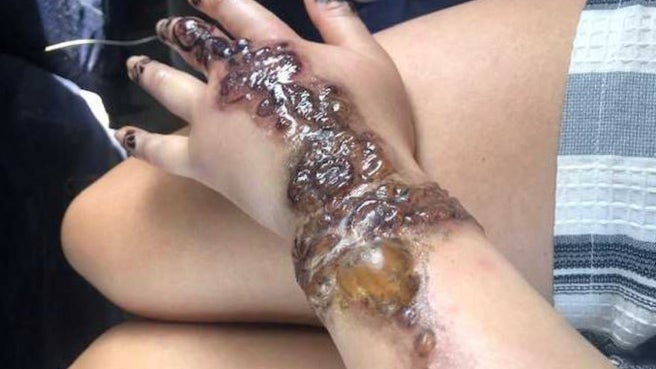


A young Adelaide nurse is hoping the story of how a $5 henna tattoo left her hand swollen, blistering and oozing puss, will remind people to be vigilant when getting their own temporary tattoos abroad.
Brooke Crannaford has spent plenty of time in Africa — recently working at a small birthing hospital in Nairobi, Kenya as part of her third mission trip to the continent.
However, during a trip to Egypt with her partner in late 2018, the 25-year-old quickly found herself playing patient after a horrific reaction to chemicals in ‘black henna’ pigment used on her skin.
“We were visiting a small village in Aswan,” she told 10 daily.
“They were offering ‘natural henna’ for around $5 AUD. I was so excited as during recent trips to India and at home, I had had henna done before and it was fine on my skin.”
Henna tattooing — a non-penetrative form of body art which leaves a temporary mark on the skin — is traditionally created using natural materials derived from a small tree of the same name.
When unadulterated, it will stain the skin somewhere between red, orange, brown or burgundy.
Black henna — which often contains a toxic chemical called Paraphenylenediamine (PPD) — is capable of causing allergic reactions and permanently damaging skin.
Crannaford began to realise her skin was reacting to the tattoo when it became itchy a few hours later.
“Progressively over the next 48 hours it’s got a lot worse, swelling, blistering, oozing puss, and a lot of pain. The only way to relieve the pain was by holding my arm up in the air,” she said.
Despite attempting to treat it herself with antiseptic cream and anti-inflammatory drugs, Crannaford’s entire hand became swollen and developed blisters “the size of 50c pieces”.
By the time she made it to a hospital, the pain had subsided due to nerve damage.
Crannaford was treated for grade three cellulitis — an infection of the skin caused by bacteria — and a second to third-degree chemical burn.
“It took a week of IV antibiotics and three hourly dressing changes. Two more weeks of steroids and anti-inflammatory drugs. I ended up having two weeks off work once home until the wound healed enough for me to wash my hands at work,” she said of her recovery.
“Still today I have very limited feeling in my pinky finger.”
PPD is mainly used in black hair dyes in very small amounts and is illegal to use on the skin in Australia. When used in henna, it leaves a darker stain on the skin in a fraction of the time compared with natural materials.
Crannaford — who was unaware PPD was ever used in henna — knew she was allergic to the substance after having a reaction to hair dye in the past.
The Australian Department of Foreign Affairs and Trade advises travellers to avoid temporary black henna tattoos.
Earlier this week, House Call Doctor‘s Dr Ryan Harvey issued a warning to travellers about the dangers of black henna tattooing — particularly for children.
“Unlike here in Australia, there may not be any regulation of what goes into the dye, and children in particular can have extreme reactions that can cause blistering, open sores and a chemical burn,” Harvey said.
“While many parents think getting a temporary Henna tattoo is harmless holiday fun, it can lead to permanent scarring.”
As Sydney-based Henna artist Fareha Ahmed told 10 daily, natural henna will never be black and takes at least 24 hours to properly stain the skin — but substances containing added chemicals will do the job almost instantly.
Crannaford said she was not aware of the potential risks when getting the temporary tattoo done, and the term ‘black henna’ was never even mentioned.
“Thinking back, even if they didn’t mention it was ‘black’ henna, I probably wouldn’t have known it was hair dye they added to make it black and still probably would have got it done,” she said.
Moving forward, she hopes more people will have the forethought to ask what chemicals — if any — are being used, and take the time to perform a spot test before having an entire design drawn on.
Original Source: 10 Daily | 11 July 2019




